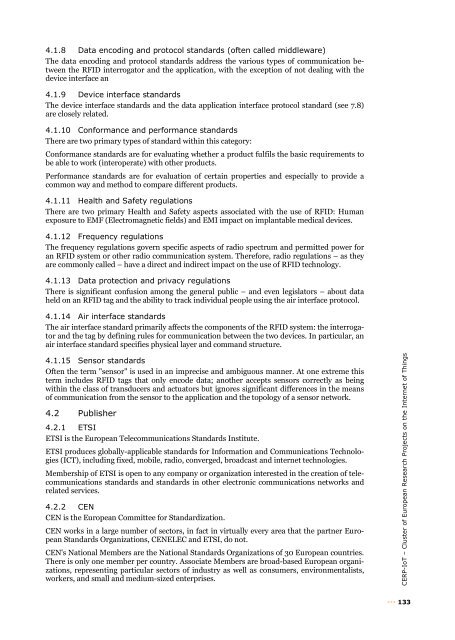Vision and Challenges for Realising the Internet of Things
Vision and Challenges for Realising the Internet of Things
Vision and Challenges for Realising the Internet of Things
You also want an ePaper? Increase the reach of your titles
YUMPU automatically turns print PDFs into web optimized ePapers that Google loves.
4.1.8 Data encoding <strong>and</strong> protocol st<strong>and</strong>ards (<strong>of</strong>ten called middleware)<br />
The data encoding <strong>and</strong> protocol st<strong>and</strong>ards address <strong>the</strong> various types <strong>of</strong> communication between<br />
<strong>the</strong> RFID interrogator <strong>and</strong> <strong>the</strong> application, with <strong>the</strong> exception <strong>of</strong> not dealing with <strong>the</strong><br />
device interface an<br />
4.1.9 Device interface st<strong>and</strong>ards<br />
The device interface st<strong>and</strong>ards <strong>and</strong> <strong>the</strong> data application interface protocol st<strong>and</strong>ard (see 7.8)<br />
are closely related.<br />
4.1.10 Con<strong>for</strong>mance <strong>and</strong> per<strong>for</strong>mance st<strong>and</strong>ards<br />
There are two primary types <strong>of</strong> st<strong>and</strong>ard within this category:<br />
Con<strong>for</strong>mance st<strong>and</strong>ards are <strong>for</strong> evaluating whe<strong>the</strong>r a product fulfils <strong>the</strong> basic requirements to<br />
be able to work (interoperate) with o<strong>the</strong>r products.<br />
Per<strong>for</strong>mance st<strong>and</strong>ards are <strong>for</strong> evaluation <strong>of</strong> certain properties <strong>and</strong> especially to provide a<br />
common way <strong>and</strong> method to compare different products.<br />
4.1.11 Health <strong>and</strong> Safety regulations<br />
There are two primary Health <strong>and</strong> Safety aspects associated with <strong>the</strong> use <strong>of</strong> RFID: Human<br />
exposure to EMF (Electromagnetic fields) <strong>and</strong> EMI impact on implantable medical devices.<br />
4.1.12 Frequency regulations<br />
The frequency regulations govern specific aspects <strong>of</strong> radio spectrum <strong>and</strong> permitted power <strong>for</strong><br />
an RFID system or o<strong>the</strong>r radio communication system. There<strong>for</strong>e, radio regulations – as <strong>the</strong>y<br />
are commonly called – have a direct <strong>and</strong> indirect impact on <strong>the</strong> use <strong>of</strong> RFID technology.<br />
4.1.13 Data protection <strong>and</strong> privacy regulations<br />
There is significant confusion among <strong>the</strong> general public – <strong>and</strong> even legislators – about data<br />
held on an RFID tag <strong>and</strong> <strong>the</strong> ability to track individual people using <strong>the</strong> air interface protocol.<br />
4.1.14 Air interface st<strong>and</strong>ards<br />
The air interface st<strong>and</strong>ard primarily affects <strong>the</strong> components <strong>of</strong> <strong>the</strong> RFID system: <strong>the</strong> interrogator<br />
<strong>and</strong> <strong>the</strong> tag by defining rules <strong>for</strong> communication between <strong>the</strong> two devices. In particular, an<br />
air interface st<strong>and</strong>ard specifies physical layer <strong>and</strong> comm<strong>and</strong> structure.<br />
4.1.15 Sensor st<strong>and</strong>ards<br />
Often <strong>the</strong> term "sensor" is used in an imprecise <strong>and</strong> ambiguous manner. At one extreme this<br />
term includes RFID tags that only encode data; ano<strong>the</strong>r accepts sensors correctly as being<br />
within <strong>the</strong> class <strong>of</strong> transducers <strong>and</strong> actuators but ignores significant differences in <strong>the</strong> means<br />
<strong>of</strong> communication from <strong>the</strong> sensor to <strong>the</strong> application <strong>and</strong> <strong>the</strong> topology <strong>of</strong> a sensor network.<br />
4.2 Publisher<br />
4.2.1 ETSI<br />
ETSI is <strong>the</strong> European Telecommunications St<strong>and</strong>ards Institute.<br />
ETSI produces globally-applicable st<strong>and</strong>ards <strong>for</strong> In<strong>for</strong>mation <strong>and</strong> Communications Technologies<br />
(ICT), including fixed, mobile, radio, converged, broadcast <strong>and</strong> internet technologies.<br />
Membership <strong>of</strong> ETSI is open to any company or organization interested in <strong>the</strong> creation <strong>of</strong> telecommunications<br />
st<strong>and</strong>ards <strong>and</strong> st<strong>and</strong>ards in o<strong>the</strong>r electronic communications networks <strong>and</strong><br />
related services.<br />
4.2.2 CEN<br />
CEN is <strong>the</strong> European Committee <strong>for</strong> St<strong>and</strong>ardization.<br />
CEN works in a large number <strong>of</strong> sectors, in fact in virtually every area that <strong>the</strong> partner European<br />
St<strong>and</strong>ards Organizations, CENELEC <strong>and</strong> ETSI, do not.<br />
CEN's National Members are <strong>the</strong> National St<strong>and</strong>ards Organizations <strong>of</strong> 30 European countries.<br />
There is only one member per country. Associate Members are broad-based European organizations,<br />
representing particular sectors <strong>of</strong> industry as well as consumers, environmentalists,<br />
workers, <strong>and</strong> small <strong>and</strong> medium-sized enterprises.<br />
CERP-IoT – Cluster <strong>of</strong> European Research Projects on <strong>the</strong> <strong>Internet</strong> <strong>of</strong> <strong>Things</strong><br />
133
















